Stephanie Mecalis is in her fourth year as a student at Portland State University. Her tuition and fees to attend the school are covered by a combination of state and federal grants and Portland State’s tuition-free degree program. Money from her federal work-study program and food stamps from the federal Supplemental Nutrition Assistance Program help with her other expenses. And she lives rent-free with relatives nearby.

U.S. Rep. Suzanne Bonamici, center in pink jacket, heard about the challenges student borrowers are facing today from Portland-area college students, financial aid experts and consumer protection advocates at Portland Community College, April 8, 2024.
Lauren Jin / Courtesy of Rep. Bonamici's office
Mecalis is grateful to have no student loans at all. But she knows very well that most of her peers are not as fortunate because she also works at Portland State’s financial aid office. More than half of Portland State graduates — 55% — leave with some form of student loan debt, according to the Institute for College Access & Success.
“So many times I’m talking to students who, even though they have enough grants, scholarships or a tuition remission, they don’t have enough to pay their rent or for food,” said Mecalis, who helps fellow students understand student loans. “A lot of the time that’s why they have to take out loans.”
Mecalis shared her experiences on college costs and student loans at a roundtable on student loan debt on Monday. The discussion was held at Portland Community College’s Rock Creek campus and hosted by U.S. Rep. Suzanne Bonamici, D-Beaverton, and included students, financial leaders from some of the state’s higher education institutions and other student loan experts.
The roundtable comes ahead of a series of planned student loan workshops across Northwest Oregon, also hosted by Bonamici, intended to inform borrowers of a slate of new and updated federal loan forgiveness programs, repayment options and an upcoming April 30th eligibility deadline for certain borrowers. It also comes as the White House announced a new plan Monday to provide debt relief to millions of student loan borrowers across the country.
Attendees at Monday’s discussion talked about what changes they would like to see with the federal government’s student loan system to make it work better for students. Accountability and simplification were the keywords thrown out again and again.
“It’s complicated and it should not be,” said Bonamici. “In the long term, I’m working hard to make the process work better for everyone and to make higher education affordable and debt-free.”
Oregon’s first-ever student loan ombudsman Lane Thompson, who participated in Monday’s roundtable, played a key role in creating the Biden Administration’s new debt forgiveness proposal. Thompson represented state higher education agencies in a student loan debt relief committee convened by the U.S. Department of Education that came up with the initial plans announced Monday.
From her post within the Oregon Department of Consumer and Business Services, Thompson helps borrowers resolve complaints with student loan servicers.
Thompson said she hears from Oregonians nearly every day who are trying to navigate through repayment and loan forgiveness programs with their student loans. Many of the calls to her office have to deal with last fall’s return to repayment after a COVID-era three-year pause on student loan payments enacted by the Biden Administration. Thompson said she’s heard from borrowers trying to sort out repayment plans who are dealing with hours-long wait times with loan servicers and dropped calls.
“There is a lot of confusion, not because people are poorly informed, but because there’s a lack of accountability between the loan servicers and the Department of Education,” said Thompson.
Thompson wants to see a simpler process for borrowers seeking more affordable repayment options or debt cancellation.
Mike Pierce of the Student Borrower Protection Center agreed that more accountability is needed, noting the federal government relies heavily on private contractors to service federal loans.
“But that shouldn’t be a student borrower’s problem,” said Pierce. “If we’re going to continue to use private contractors then there needs to be safeguards in place for borrowers when things go wrong and simplifying the student loan system is one of the best ways that you can prevent things from going wrong.”
Pierce said he is seeing more protections for borrowers from the Biden Administration, like its reform and expansion of student loan debt cancellation under the Public Service Loan Forgiveness program.
Portland State student Mecalis said when it comes to taking out loans in the first place, many students don’t have the information they need because they are rushed through the process.
“I’m still getting questions all the time like, ‘I don’t know my interest rate or I don’t know about repayment’,” said Mecalis. “In theory, they should have learned or been told through loan entrance counseling.”
Financial aid leaders at the meeting said schools need to rethink engagement with students about how to pay for higher education at several points along the students’ college path: before they commit to a school, while they are pursuing their degree and shortly before graduation.
And even though there’s still plenty of room for improvement in the federal student loan realm, Thompson said now is a good time for borrowers to re-engage with their loans.
“There’s a lot of programs, a lot of resources that weren’t available before,” said Thompson. “So if you applied for forgiveness in the past and were rejected, you might consider applying again now or if the plans weren’t affordable, there’s more affordable plans now.”
